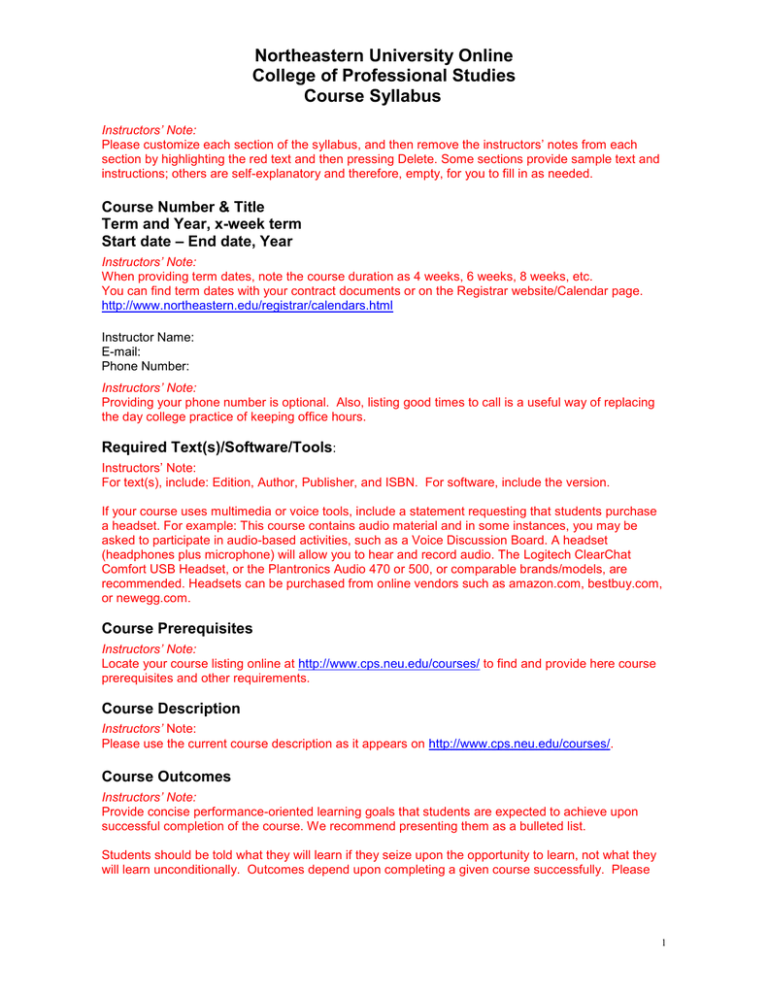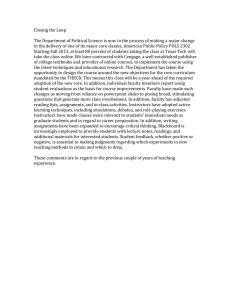
Northeastern University Online
College of Professional Studies
Course Syllabus
Instructors’ Note:
Please customize each section of the syllabus, and then remove the instructors’ notes from each
section by highlighting the red text and then pressing Delete. Some sections provide sample text and
instructions; others are self-explanatory and therefore, empty, for you to fill in as needed.
Course Number & Title
Term and Year, x-week term
Start date – End date, Year
Instructors’ Note:
When providing term dates, note the course duration as 4 weeks, 6 weeks, 8 weeks, etc.
You can find term dates with your contract documents or on the Registrar website/Calendar page.
http://www.northeastern.edu/registrar/calendars.html
Instructor Name:
E-mail:
Phone Number:
Instructors’ Note:
Providing your phone number is optional. Also, listing good times to call is a useful way of replacing
the day college practice of keeping office hours.
Required Text(s)/Software/Tools:
Instructors’ Note:
For text(s), include: Edition, Author, Publisher, and ISBN. For software, include the version.
If your course uses multimedia or voice tools, include a statement requesting that students purchase
a headset. For example: This course contains audio material and in some instances, you may be
asked to participate in audio-based activities, such as a Voice Discussion Board. A headset
(headphones plus microphone) will allow you to hear and record audio. The Logitech ClearChat
Comfort USB Headset, or the Plantronics Audio 470 or 500, or comparable brands/models, are
recommended. Headsets can be purchased from online vendors such as amazon.com, bestbuy.com,
or newegg.com.
Course Prerequisites
Instructors’ Note:
Locate your course listing online at http://www.cps.neu.edu/courses/ to find and provide here course
prerequisites and other requirements.
Course Description
Instructors’ Note:
Please use the current course description as it appears on http://www.cps.neu.edu/courses/.
Course Outcomes
Instructors’ Note:
Provide concise performance-oriented learning goals that students are expected to achieve upon
successful completion of the course. We recommend presenting them as a bulleted list.
Students should be told what they will learn if they seize upon the opportunity to learn, not what they
will learn unconditionally. Outcomes depend upon completing a given course successfully. Please
1
note that, here as in “Course Description” above, there should be no descriptive language that
specifies or implies deliverables.
So, for example, instead of a statement like the following: “Students will become conversant with and
knowledgeable about the major historical forces that have shaped Eastern Europe from the end of the
Middle Ages through the present,” a statement like the following might be substituted: “Students will
have the opportunity to become conversant with and knowledgeable about the major historical forces
that have shaped Eastern Europe from the end of the Middle Ages through the present.”
The former statement provides grounds for consumerist litigation if the student does not become
conversant with and knowledgeable about the course’s subject matter. The latter statement places
the opportunity to learn and the responsibility for doing so squarely where both should be placed: with
the student.
Course Methodology
Each week, you will be expected to:
1. Review the week's learning objectives.
2. Complete all assigned readings.
3. Complete all lecture materials for the week.
4. Participate in the Discussion Board.
5. Complete and submit all assignments and tests by the due dates.
Instructors’ Note:
This is a sample summary of the general course workflow and structure in Blackboard. You should
also explain how much time students will spend reading, researching, participating in online
discussions, completing assignments, tests, and presentations, etc.
Participation/Discussion Board
Instructors’ Note:
Set participation expectations for the students here. Tell students:
How much participation in the discussion board is required; we recommend that each week
students must post at least one “primary response” (answering a discussion question) and
two secondary responses (responses to other students’ posts).
How much participation is worth (it should be at least 20-30% of the total course grade).
When responses to the discussion board are due.
What types of responses are required (content, tone, quantity, and quality).
Communication/Submission of Work
In the Assignments folder, click on the View/Complete Assignment link to view and each assignment.
Attach your completed assignments here and click Submit to turn them in to me. Once your
assignment has been graded, you will be able to view the grade and feedback I have provided by
clicking on My Grades in the Tools module from the Northeastern University Online Campus tab.
Instructors’ Note:
These are sample instructions for how students submit work directly to you.
Set expectations for how students should communicate with you and with each other. Encourage
students to post content-oriented communication in the Discussion Board instead of in e-mail so that
all students can benefit from each other’s learning.
Grading/Evaluation Standards
Instructors’ Note:
Tell students how their work will be evaluated and how assignments, quizzes, tests, participation, etc.
will be weighted. Be specific.
2
Assign precise numerical values to all work that will be evaluated for the student’s final grade in the
course, taking care that the numerical values add up to or may be converted to 100%. Please be
specific about the course policy for work that is late without an excuse or for missing class (and class
participation).
Students have a right to know what an instructor will be looking for in the work that they submit.
Include a succinct and concrete statement of your evaluation standards, closely linked with and
making reference to the discussion of grading standards in the CPS Student Handbook, available at
http://cps.neu.edu/student-resources/. Alternately, simply refer the students to that discussion. Also,
you should have the reasonable expectation that students’ written work be clear, comprehensible,
and competently produced – please include a statement to that effect here.
GUIDELINES FOR TERM PAPER/FINAL PROJECT/FINAL REPORT (if any):
You may also distribute these guidelines as a detailed, separate document. In fact, doing so at the
appropriate time in the term can help lower students’ stress and anxiety at the beginning of the term.
However, include at least a general initial statement of what the final piece will be, what its
methodology will consist of, and how long it will be.
Class Schedule / Topical Outline
Week
Dates
1
Week start –
Week end
2
Week start –
Week end
3
Week start –
Week end
4
Week start –
Week end
5
Week start –
Week end
6
Week start –
Week end
7
Week start –
Week end
8
Week start –
Week end
9
Week start –
Week end
10
Week start –
Week end
11
Week start –
Week end
12
Week start –
Week end
Topic
Assignments
Instructors’ Note:
Enter dates for the term. Note that each week runs from Monday through Sunday with the exception
of the last week of the term, which ends on Saturday. If needed, right-click on a table row to delete or
3
add rows to include the correct number of weeks in the term. If the class is blended or hybrid, indicate
which weeks, topics, and/or assignments take place on ground and which take place online.
You can find term dates with your contract documents or on the Registrar website/Calendar page.
http://www.northeastern.edu/registrar/calendars.html
Academic Integrity Policy
The University views academic dishonesty as one of the most serious offenses that a student can
commit while in college and imposes appropriate punitive sanctions on violators. Here are some
examples of academic dishonesty. While this is not an all-inclusive list, we hope this will help you to
understand some of the things instructors look for. The following is excerpted from the University’s
policy on academic integrity; the complete policy is available in the Student Handbook. The Student
Handbook is available on the CPS Student Resources page > Policies and Forms.
Cheating – intentionally using or attempting to use unauthorized materials, information or study aids
in an academic exercise
Fabrication – intentional and unauthorized falsification, misrepresentation, or invention of any data, or
citation in an academic exercise
Plagiarism – intentionally representing the words, ideas, or data of another as one’s own in any
academic exercise without providing proper citation
Unauthorized collaboration – instances when students submit individual academic works that are
substantially similar to one another; while several students may have the same source material, the
analysis, interpretation, and reporting of the data must be each individual’s independent work.
Participation in academically dishonest activities – any action taken by a student with the intent of
gaining an unfair advantage
Facilitating academic dishonesty – intentionally or knowingly helping or attempting to violate any
provision of this policy
For more information on Academic Integrity, including examples, please refer to the Student
Handbook, pages 9-11.
Northeastern University Online Policies and Procedures
For comprehensive information please go to http://www.cps.neu.edu/online/
Northeastern University Online Copyright Statement
Northeastern University Online is a registered trademark of Northeastern University.
All other brand and product names are trademarks or registered trademarks of their respective
companies.
This course material is copyrighted and Northeastern University Online reserves all rights. No part of
this publication may be reproduced, transmitted, transcribed, stored in a retrieval system, or
translated into any language or computer language, in any form or by any means, electronic,
mechanical, magnetic, optical, chemical, manual, or otherwise, without the express prior written
permission of Northeastern University Online.
Copyright YEAR © by Northeastern University Online
All Rights Reserved
Instructors’ Note: Enter the current year for copyright.
4


